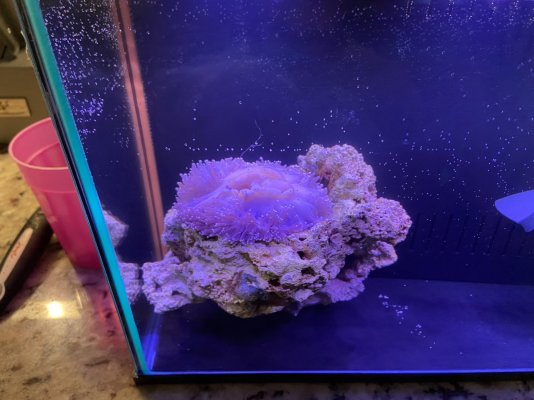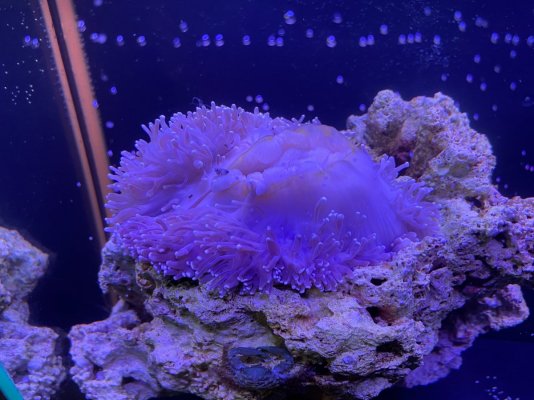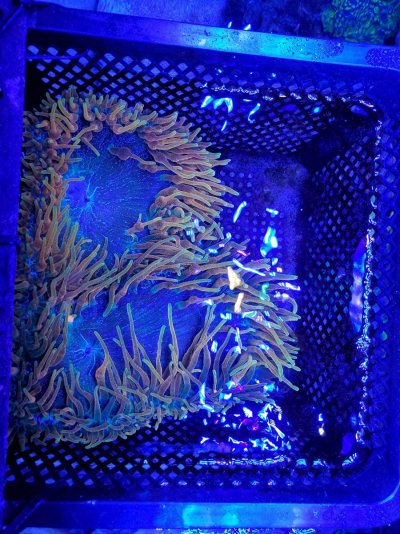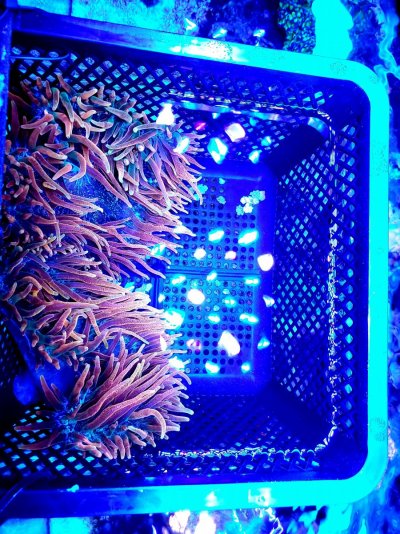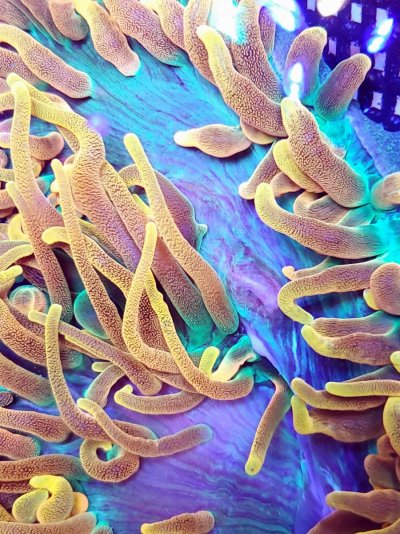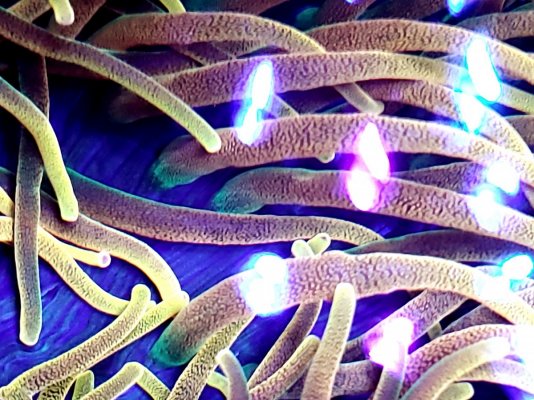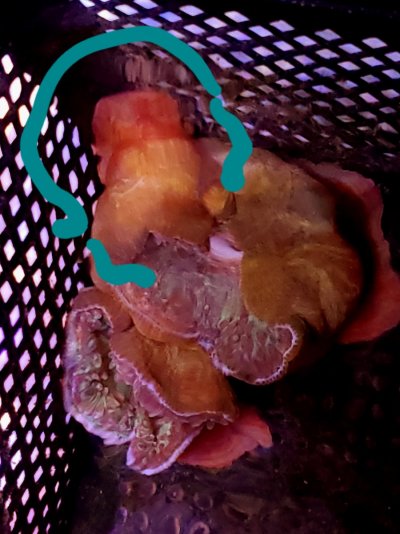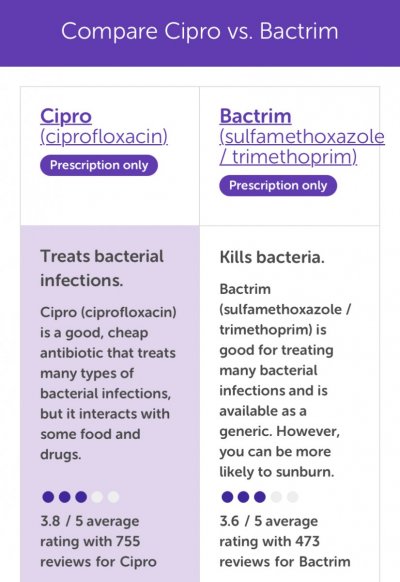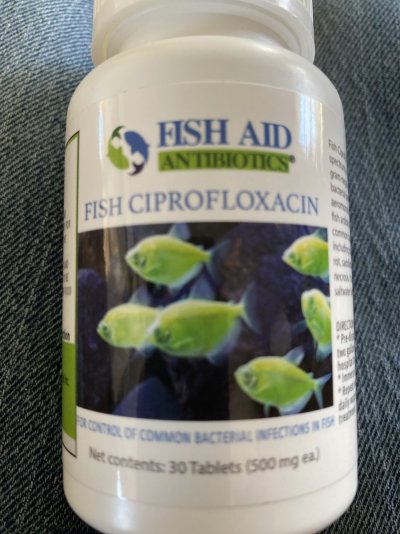Thx for this! All great info. Didn’t occur to me that I needed to turn the light off in the QT tank. Ran downstairs and shut the light off because the nem has been in the light all day in the regular tank. It’s a cheap tank I picked up from pet smart but I think I need to go back and get a better quality light. The light that came with it is very weak.I used the same exact one. On 2 colorado sunburst nems.
Heres what i did.
I kept them in a basket. Black square ones sold at home depot for ponds.
Had a tote just big enough to fit it and a cheap powerhead from walmart.
Filled the tote with enough water to keep nems completely covered and basket floated, about 3gal. Powerhead NOT POINTED directly at nems.
1 500MG pill oee day, right before lights out.
I used a black box led with bothe channels at about 60%.
12hrs on 12 off.
Change the water at least 1 time a day, before dosing.
If there is slime or poop, change twice a day.
Continue dosing at least 10 days. I did 15.
No feeding. And use fresh saltwater each water change you dont want to use water that has had time to build bacteria in it.
Navigation
Install the app
How to install the app on iOS
Follow along with the video below to see how to install our site as a web app on your home screen.
Note: This feature may not be available in some browsers.
More options
You are using an out of date browser. It may not display this or other websites correctly.
You should upgrade or use an alternative browser.
You should upgrade or use an alternative browser.
Protocol for using antibiotics to treat infected anemones
- Thread starter OrionN
- Start date
- Tagged users None
- Joined
- May 13, 2017
- Messages
- 2,453
- Reaction score
- 1,280
My csb lost all the tentacles and recovered. Actually since recovering they have split multiple times each.Hey doc I just started treatment and notice about 10 tentacles twisted and couple fell off. Should be fine? Also I’m giving 12 hours of light and 12 of dark. Does that seem alright or back the light off? I’m on my second day of treatment. First started with lights on and mouth was open wide. Once the light went out still open wide mouth. This morning when I switch the lights on it reacted and closed tight. Here is some pictures.
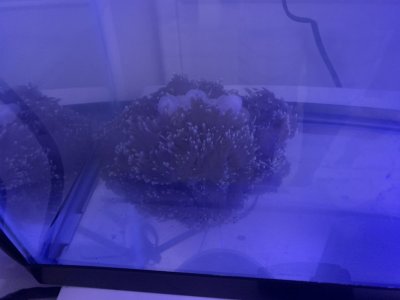
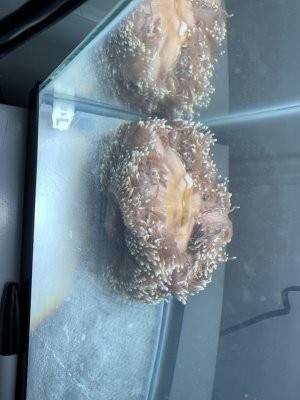
Moved my nem to an individual tank lastnight and started the treatment and I must admit, I think I lost him. The mouth is super wide open.
I’m banning myself from ritteri for at least a year if this lil guy doesn’t make it. It’s extremely disheartening to watch and something I could have avoided if I was patient.
I’m banning myself from ritteri for at least a year if this lil guy doesn’t make it. It’s extremely disheartening to watch and something I could have avoided if I was patient.
Attachments
- Joined
- May 13, 2017
- Messages
- 2,453
- Reaction score
- 1,280
Dont give up hope. Open mouth is it trying to expel the internal bacteria.Moved my nem to an individual tank lastnight and started the treatment and I must admit, I think I lost him. The mouth is super wide open.
I’m banning myself from ritteri for at least a year if this lil guy doesn’t make it. It’s extremely disheartening to watch and something I could have avoided if I was patient.
My csb lost all tentacles and kept sluffing off slime.
Here is how they look now 6 months later. The last pic is them post meds but still needing to heal up. As you can see they started splitting once they started to heal.
Attachments
Thx for helping me keep hope alive! Lol! I need all the encouragement I can get.Dont give up hope. Open mouth is it trying to expel the internal bacteria.
My csb lost all tentacles and kept sluffing off slime.
Here is how they look now 6 months later. The last pic is them post meds but still needing to heal up. As you can see they started splitting once they started to heal.
Can bactrim be used?This is a re-post of what I wrote in ReefCentral on 3/09/2013
Many anemone keepers know, the collection and shipping process from ocean to local fish store (LFS) is a stressful event. Most host anemones do not survive this process without help, especially H. magnifica and S. gigantea. Other host anemones also have high mortality. Most succumb to infection in the first 4 weeks on arrival to LFS. With help from other anemone keepers at ReefCentral.com Anemones and Clownfish Forum, I have come up with an antibiotic protocol that seems to be successful and drastically improve the initial survival of anemones during this critical time.
The antibiotic choice: Ciprofloxacin (Cipro), a floroquinone antibiotic or Trimethoprim/sulfamethoxazole (Septra) combination antibiotic
There are several reasons I choose these antibiotics. They are broad spectrum antibiotics that should, hopefully, cover most pathogens involved. These antibiotics covered most of the pathogens involved in a saltwater wound infection in humans. This is not to say that pathogen that infected the anemones are the same ones that infected human. However, we have to start somewhere and these two antibiotic are reasonable choices. The other reason for choosing these antibiotic is that they are inexpensive and widely available. Cipro and Septra dissolve well in water and will break down with light exposure in a tank environment. Another antibiotic that can be use is levofloxacin (Levaquin). However, Levaquin is a newer fluroquinone and much more expensive because generic are not available.
Instruction:
The dosage for continuous exposure (not dipping) in a hospital tank is Cipro 250 mg or Septra 160/800 mg per every 10 gal of water. I recommended that anemone be treated in hospital tank. I used a standard 20 gallon (high) tank, power head (PH) , heater, egg crate and possibly an air stone. I also recommended that full light is provide for the anemone to help it recover via photosynthesis. The hospital tank is divide into two compartments by the egg crate. Place the anemone with an inert object (a mug or a medium piece of rock) for it to attach to in one compartment. In the other compartment place the heater, PH and +/-air stone.
Fill the hospital tank half way (10 gal) and added either Septra or Cipro, then added the sick anemone. The hospital tank water needs to be keep stable with respect to temperature and salinity. I recommend that all the water in hospital tank be change daily as the day-time cycle comes to an end. After a water change add antibiotic. The best method to add antibiotic into the hospital tank is to rub the tablet between thumb and index finger in front of the PH until fully dissolved. With reasonable light, it is likely that all or most of the antibiotic will be degraded by the end of the day-time cycle. Adding medication at the begin of the night-time cycle, should give optimal antibiotic exposure for the anemone for most of the 24 hour time period. Adequate circulation, with small PH, is a must. The hospital tank will have a minimal ability to process ammonia, therefore feeding sick anemone is not recommended during treatment process. I do not recommend tapering the dosage of the antibiotic because low level antibiotic treatment is what causes problems and creates resistant strains of bacteria.
Anemones often discharge various substance when they are not well. When the hospital tank water have solid discharge, I recommend removal of these discharge. At any time, if the water of the hospital tank is cloudy, I recommend a 100% water change and new antibiotic added.
Length of treatment:
It is recommended that the anemone is treated for a minimum of 7 days, and at least 3 days after it stops deflating. Early termination of treatment is a mistake that has caused me to loose a few anemones.
Disposal of antibiotic containing water:
There is no special treatment needed for disposing water containing antibiotics. Cipro and Septra will break down quickly with light exposure and will not stay around long in the environment. Short course of antibiotic use like in this protocol should not have significant impact on the environment. It is harmful for the environment if there is a continuous low level antibiotic discharge, but not for short courses like in this protocol . In human usage, these two antibiotics are eliminated unchanged by the kidney, and flushed down the toilet into the sewage system, which is what we are doing with our treatment water. It is unclear if treatment by bleach will do anything to the antibiotic. If you are concerned, store the water and put it under sunlight for a few days then discard.
I clean the hospital tank and all equipment thoroughly include bleaching the full set up in fresh water. Once thoroughly cleaned, the hospital tank can be dry and put into storage until needed.
Attachments
Also, to change the water every day I would need to mix water everyday. Which, wouldn’t new water be bad to a ritteri that typically requires a 1-year established tank?This is a re-post of what I wrote in ReefCentral on 3/09/2013
Many anemone keepers know, the collection and shipping process from ocean to local fish store (LFS) is a stressful event. Most host anemones do not survive this process without help, especially H. magnifica and S. gigantea. Other host anemones also have high mortality. Most succumb to infection in the first 4 weeks on arrival to LFS. With help from other anemone keepers at ReefCentral.com Anemones and Clownfish Forum, I have come up with an antibiotic protocol that seems to be successful and drastically improve the initial survival of anemones during this critical time.
The antibiotic choice: Ciprofloxacin (Cipro), a floroquinone antibiotic or Trimethoprim/sulfamethoxazole (Septra) combination antibiotic
There are several reasons I choose these antibiotics. They are broad spectrum antibiotics that should, hopefully, cover most pathogens involved. These antibiotics covered most of the pathogens involved in a saltwater wound infection in humans. This is not to say that pathogen that infected the anemones are the same ones that infected human. However, we have to start somewhere and these two antibiotic are reasonable choices. The other reason for choosing these antibiotic is that they are inexpensive and widely available. Cipro and Septra dissolve well in water and will break down with light exposure in a tank environment. Another antibiotic that can be use is levofloxacin (Levaquin). However, Levaquin is a newer fluroquinone and much more expensive because generic are not available.
Instruction:
The dosage for continuous exposure (not dipping) in a hospital tank is Cipro 250 mg or Septra 160/800 mg per every 10 gal of water. I recommended that anemone be treated in hospital tank. I used a standard 20 gallon (high) tank, power head (PH) , heater, egg crate and possibly an air stone. I also recommended that full light is provide for the anemone to help it recover via photosynthesis. The hospital tank is divide into two compartments by the egg crate. Place the anemone with an inert object (a mug or a medium piece of rock) for it to attach to in one compartment. In the other compartment place the heater, PH and +/-air stone.
Fill the hospital tank half way (10 gal) and added either Septra or Cipro, then added the sick anemone. The hospital tank water needs to be keep stable with respect to temperature and salinity. I recommend that all the water in hospital tank be change daily as the day-time cycle comes to an end. After a water change add antibiotic. The best method to add antibiotic into the hospital tank is to rub the tablet between thumb and index finger in front of the PH until fully dissolved. With reasonable light, it is likely that all or most of the antibiotic will be degraded by the end of the day-time cycle. Adding medication at the begin of the night-time cycle, should give optimal antibiotic exposure for the anemone for most of the 24 hour time period. Adequate circulation, with small PH, is a must. The hospital tank will have a minimal ability to process ammonia, therefore feeding sick anemone is not recommended during treatment process. I do not recommend tapering the dosage of the antibiotic because low level antibiotic treatment is what causes problems and creates resistant strains of bacteria.
Anemones often discharge various substance when they are not well. When the hospital tank water have solid discharge, I recommend removal of these discharge. At any time, if the water of the hospital tank is cloudy, I recommend a 100% water change and new antibiotic added.
Length of treatment:
It is recommended that the anemone is treated for a minimum of 7 days, and at least 3 days after it stops deflating. Early termination of treatment is a mistake that has caused me to loose a few anemones.
Disposal of antibiotic containing water:
There is no special treatment needed for disposing water containing antibiotics. Cipro and Septra will break down quickly with light exposure and will not stay around long in the environment. Short course of antibiotic use like in this protocol should not have significant impact on the environment. It is harmful for the environment if there is a continuous low level antibiotic discharge, but not for short courses like in this protocol . In human usage, these two antibiotics are eliminated unchanged by the kidney, and flushed down the toilet into the sewage system, which is what we are doing with our treatment water. It is unclear if treatment by bleach will do anything to the antibiotic. If you are concerned, store the water and put it under sunlight for a few days then discard.
I clean the hospital tank and all equipment thoroughly include bleaching the full set up in fresh water. Once thoroughly cleaned, the hospital tank can be dry and put into storage until needed.
Bactrim and Septra are the same medication. Different brand names for the same med.Can bactrim be used?
Newly mix salt water is not bad as long as the salt is completely dissolved, heat to tank temperature and salinity correctly adjusted. I aged it for 24 hrs also but many people do not.Also, to change the water every day I would need to mix water everyday. Which, wouldn’t new water be bad to a ritteri that typically requires a 1-year established tank?
What are your thoughts about the bactrim in place of the cipro?Bactrim and Septra are the same medication. Different brand names for the same med.
Newly mix salt water is not bad as long as the salt is completely dissolved, heat to tank temperature and salinity correctly adjusted. I aged it for 24 hrs also but many people do not.
Bactrim is not as good, but can be use. The write up give dosage for both meds.
- Joined
- May 13, 2017
- Messages
- 2,453
- Reaction score
- 1,280
"Ciprofloxacin Tablets 250mg (30 Tablets) | On Sale | EntirelyPets Rx" https://entirelypetspharmacy.com/ci...nmu3hRzEcpeS3YaJppmireKile2xpAmAaAtQdEALw_wcBCan somebody post some links of where to buy the medications. I can't find it on either amazon or BRS.
Thanks.
- Joined
- May 13, 2017
- Messages
- 2,453
- Reaction score
- 1,280
I did. I got the 500mg pills and I dosed a whole pill to about 3 gal twice a day. Changing the water before each new doseCan I use this to treat a anemone
How big was the qt,my qt is aio 5 gallon tank.I did. I got the 500mg pills and I dosed a whole pill to about 3 gal twice a day. Changing the water before each new dose
Last edited:
- Joined
- May 13, 2017
- Messages
- 2,453
- Reaction score
- 1,280
About a 5 gal tote. All I did was add a small power head, zero filtration. A airstone and a small heater, all from walmart. And a 165w blackbox. Blue channel at 75% white channel at just past on. 12hr cycle.How big was the qt,my qt is aio 5 gallon tank.
2 complete water changes a day, with new dose at each water change.
My csb lost all the tentacles and were a slimy mess. I kept them in the treatment tote for about 25 days. Then another couple months in a 10g qt no real filtration, a powerhead and airstone.
After all that time I returned them to the original system and began light feeding. It was at that time tentacles grew back.
My chicagos mouth is open all the time.It is still eating but has shrunk down in size.Just want to go ahead and start treatment now.
- Joined
- May 13, 2017
- Messages
- 2,453
- Reaction score
- 1,280
Yeah I would. My coloradis got infected by a supernova that was added to a tank with other Colorado in it. The owner thought it was chemical warfare so asked me to hold a csb for them. This led to mine getting infected. I'd cut feeding completely while treating.My chicagos mouth is open all the time.It is still eating but has shrunk down in size.Just want to go ahead and start treatment now.
Thanks Shooter
Similar threads
- Replies
- 9
- Views
- 119
- Replies
- 27
- Views
- 1,068
- Replies
- 2
- Views
- 176
New Posts
-
-
New Jersey Live Rock Drygoods Beautiful Tonga Branch Rock
- Latest: ChrisfromBrick




